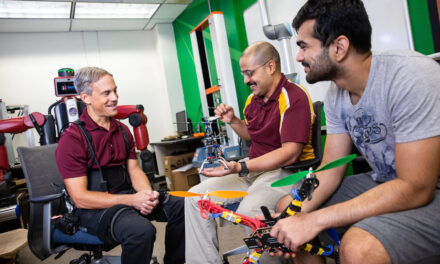
Cold storage is crucial to COVID-19 vaccine distribution

Above: New vaccines developed to counter the coronavirus require storage at low temperatures. Distribution demands carefully monitored use of refrigeration technology and specialized logistics known as a "cold chain." Photo courtesy of Shutterstock
Recent news about the coronavirus pandemic has been both harrowing and hopeful. Infections in the United States now exceed 13 million, and more than three million of those cases have emerged within just the past three weeks.
Responding to this surge, the results of large clinical trials by the pharmaceutical companies Pfizer and Moderna show their new vaccines are 94% effective or higher. Consequently, both corporations are seeking emergency use authorization from the Food and Drug Administration to start vaccinations within weeks.
Moderna reports it can have 20 million vaccine doses ready by the end of 2020, and Pfizer says it can have 50 million doses by then. Vaccination with either product requires two injections, so their combined output could mean protection for 35 million people by the end of the year.
A third vaccine has been developed by AstraZeneca, but additional trials are required to verify its efficacy. Most early results indicate 62% effectiveness, but half-size doses on initial injections may yield results as high as 90%.
These breakthroughs are very welcome in a year defined by the heavy toll of the COVID-19 pandemic. But supplying these vaccines requires a feat of logistical precision known as a “cold chain.” All three solutions must be stored at low temperatures—40 degrees Fahrenheit for the AstraZeneca product, minus 4 degrees Fahrenheit for the Moderna product and minus 94 degrees Fahrenheit for the Pfizer product. Exposure to warmer conditions, such as in transit from production facilities to storage sites, could compromise their potency and undermine the battle against the coronavirus.

Kristen Parrish
Kristen Parrish, an associate professor in the School of Sustainable Engineering and the Built Environment at Arizona State University’s Ira A. Fulton Schools of Engineering, researches the integration of energy efficiency into building design and operational processes. Her recent work includes innovating the cooling technology used in commercial freezer facilities by incorporating phase-change materials. ASU Now spoke with Parrish about aspects of successfully handling these precious new vaccines.
Question: How is vaccine deployment going to happen?
Answer: Officials are trying to figure that out right now. I have a friend who is working with the Scottsdale Fire Department to determine how to set up a large vaccination center with drive-through pop-up tents to administer injections. Keeping vaccines in fewer locations with higher-performing, temperature-controlled equipment could better ensure the necessary cold storage conditions. This is especially the case with the Pfizer product, which is likely to be the first vaccine authorized for use. Distribution will demand lots of dry ice and ultra-cold freezer units.
Q: Will it be easier to handle vaccines that don’t require such low temperatures?
A: Yes. Many commercial freezers can operate down to minus five degrees Fahrenheit, which works for the Moderna product. And the AstraZeneca vaccine can be stored at temperatures operated by conventional refrigerators. But it’s still a good idea to install separate digital temperature logging devices among the vaccine doses to verify storage conditions.
Q: All of this refrigeration suggests a lot of energy consumption. Is there some way to soften the blow?
A: Yes, this effort will represent a lot of energy use. But using a phase-change material can help on that front. These are salt hydrates in sheets of units that look like ketchup packets. When heat seeps into a freezer, for example, these passive materials absorb that heat and keep temperatures lower for longer. They don’t help you get to the low temperature you need, but they can help you stay there with less energy demand.
Q: Do these phase change materials expand our options for vaccination locations?
A: They do. I think of centralized locations using the Pfizer product, along with all of that dry ice and those ultra-cold freezers, to vaccinate health care staff and emergency responders. By contrast, getting assisted living and nursing home residents to central sites is complicated. It could be easier to send health care professionals to them — taking the Moderna or AstraZeneca vaccine doses in coolers that use phase-change materials to maintain required temperatures for several hours. This could also work for transporting vaccines to rural locations.
Q: What about technicians? Do we have people to support the required technology?
A: That could be a significant issue. We have a finite number of people trained in maintaining and repairing ultra-cold storage equipment. As part of distribution planning, facilities need to make sure they have access to people with the skills to work with these sorts of systems. The number of freezers in service and the number of maintenance calls could double very rapidly.
Q: How can universities play a role in this campaign?
A: One significant role is encouraging people to get vaccinated. ASU represents a lot of nonpartisan experts who can combat the misinformation that seems to happen around vaccines. So, our greatest service may be prompting the people of Arizona and the nation as a whole to show up and get vaccinated. Toward that end, I think about the influence of our enormous student population. If our student leaders can help share the truth about vaccination, I think that could be huge.
Q: Are you hopeful for the potential of these new vaccines?
A: I am. My family and I contracted COVID-19 during the summer. But we were lucky; we had clinically mild cases. We never had to be hospitalized and we have all since recovered. Of course, that’s not the case for a lot of people. So, distributing and administering effective vaccines offers the promise to save countless lives.


































